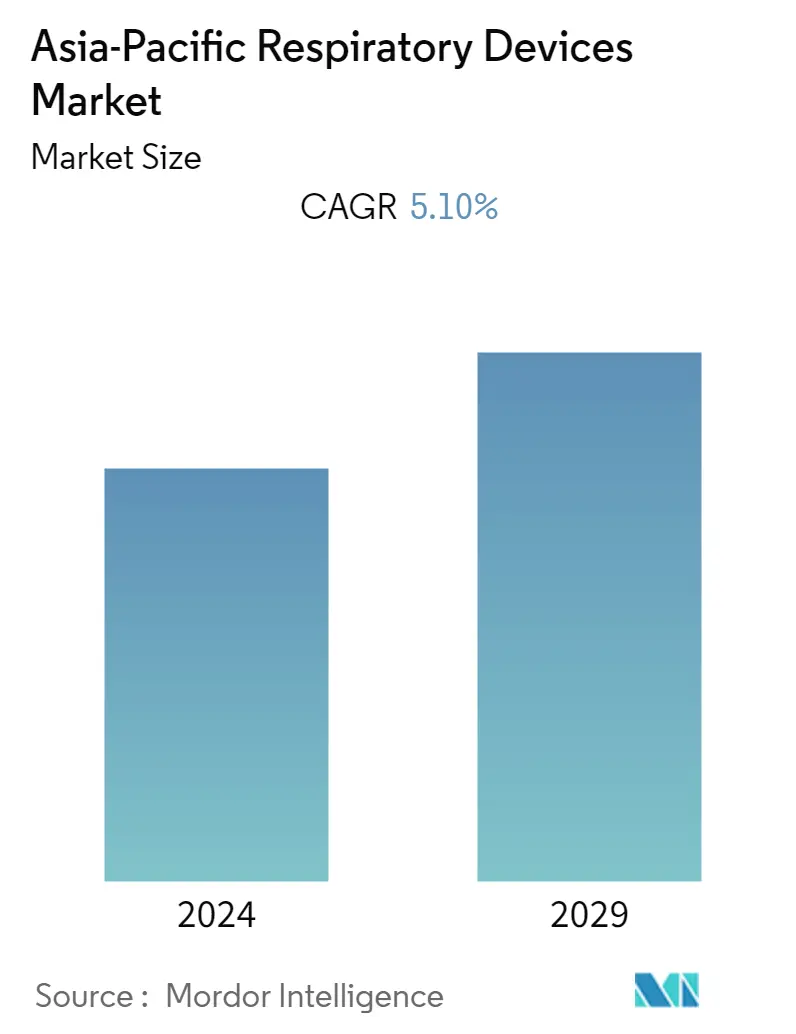Market Size of Asia-Pacific Respiratory Devices Industry

| Study Period | 2019 - 2029 |
| Base Year For Estimation | 2023 |
| Forecast Data Period | 2024 - 2029 |
| Historical Data Period | 2019 - 2022 |
| CAGR | 5.10 % |
Major Players
*Disclaimer: Major Players sorted in no particular order |
Need a report that reflects how COVID-19 has impacted this market and its growth?
Asia Pacific Respiratory Devices Market Analysis
The Asia-Pacific respiratory devices market is expected to register a CAGR of 5.1% during the forecast period.
COVID-19 has impacted the growth of the respiratory devices market in Asia-Pacific. For instance, according to a paper published in the British Journal of Surgery, an estimated 585,000 elective procedures were postponed in India alone during the 12-week shutdown, and 28.4 million elective procedures were canceled or postponed globally by May 2020. Moreover, major respiratory devices, such as ventilators, nebulizers, CPAP, BiPAP, and oxygen concentrators, witnessed high demand initially, as they are widely being used for COVID-19 patients. Thus, with the increased severity of COVID-19 in the region, several companies have increased their ventilator production to combat the pandemic. For instance, in April 2020, MEKICS Co. Ltd, a South Korean company, partnered with BIOLASE Inc. to supply ICU-grade portable ventilators through BIOLASE's FDA-registered manufacturing facility in California. Such partnerships have increased the production of portable ventilators in the country, hence impacting the market growth. Hence, the COVID-19 pandemic had a favorable impact on the market initially; currently, as the pandemic has subsided, the market has lost some traction and is expected to have stable growth during the forecast period of the study.
Factors such as the increasing prevalence of respiratory diseases such as chronic obstructive pulmonary diseases, TB, asthma, and sleep apnea, and technological advancements, as well as increasing applications in healthcare settings, are boosting market growth.
The prevalence and incidence of respiratory diseases such as asthma, chronic obstructive pulmonary diseases, and others among the population are increasing rapidly, which is anticipated to increase the demand for respiratory devices, hence propelling market growth. For instance, according to an article published in the WHO in March 2022, it has been observed that the prevalence of COPD was highest in North India and Bangladesh. In addition, as per the same source, the prevalence of chronic bronchitis ranged between 3% to 5%. Thus, the prevalence of COPD, a serious public health issue, is expected to rise, especially in emerging countries which is anticipated to increase the demand for different respiratory devices such as inhalers, nebulizers, ventilators, and others. This, in turn, is anticipated to fuel the market growth over the forecast period.
Additionally, the rising government activities and initiatives to donate respiratory devices to other countries to combat the coronavirus pandemic have also increased the production of respiratory devices in the region. This is also contributing to the market growth. For instance, in March 2022, the Ministry of Health and Family Welfare, as part of the National Health Mission's Reproductive, Maternal, Newborn, Child, Adolescent, and Adolescent Health and Nutrition (RMNCHA+N) program, developed the SAANS (Social Awareness and Actions to Neutralize Pneumonia Successfully) Initiative to reduce deaths from Childhood Pneumonia in both rural and urban areas which are expected to show significant growth over the forecast period. Also, in June 2021, the South Korean government donated 350 oxygen concentrators and 35 ventilators to help Indonesia cope with an exponential spike in COVID-19 cases. South Korea disbursed USD 4 million in funds to help Indonesia as a manifestation of cooperation to increase its capacity to handle the COVID-19 pandemic.
Furthermore, the rising company activities are also contributing to market growth. For instance, in November 2021, HoneyNaps, a South Korea-based healthcare startup, launched its medical software that uses artificial intelligence to diagnose sleep disorders. The device is called SOMNUM, the deep learning-based analysis program that enables real-time, multi-channel, large-capacity signal analysis. It automatically provides polysomnography readings that are said to be more accurate than conventional autoscoring.
Moreover, the increasing product launches in the region are expected to boost market growth. For instance, in March 2021, Vyaire Medical launched the AioCare (HealthUp SA, Poland) mobile spirometry system in more than 15 countries, including Australia and other countries. This new technology allows physicians to promptly diagnose pulmonary diseases, including asthma and COPD, as accurately as hospital-grade spirometers and performs high-quality patient monitoring via advanced digital connectivity at home.
Therefore, owing to the aforementioned factors, such as the high burden of respiratory diseases, government initiatives, and rising company activities, the studied market is anticipated to grow over the forecast period. However, the high cost of devices is likely to hinder the growth of the respiratory devices market in the Asia-Pacific region over the forecast period.
